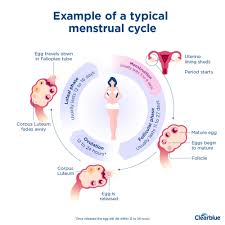Prolactin, a hormone primarily produced by the pituitary gland, plays a crucial role in reproductive health. For women, prolactin’s primary function is to promote milk production during and after pregnancy. However, when prolactin levels become abnormally high, a range of health issues, including irregular periods, can arise. One of the most effective treatments for managing high prolactin levels is a medication called Cabergoline. This article will explore the relationship between high prolactin levels and irregular menstrual cycles and how Cabergoline, in doses of Cabergoline 0.5 mg and Cabergoline 0.25 mg, can help restore hormonal balance and regulate menstruation.
Understanding Prolactin and Its Impact on Menstrual Cycles
The pituitary gland, located at the base of the brain, produces prolactin. In women, prolactin’s primary role is to stimulate milk production after childbirth. However, prolactin is also involved in regulating the menstrual cycle, though its exact role in this process is not as well understood as other reproductive hormones like estrogen and progesterone.
What Happens When Prolactin Levels Are Too High?
High prolactin levels, a condition known as hyperprolactinemia, can disrupt the balance of reproductive hormones and cause several issues related to fertility and menstruation. This condition can be caused by a variety of factors, including:
- Pituitary tumors: non-cancerous tumors of the pituitary gland, known as prolactinomas, are the most common cause of elevated prolactin levels.
- Medications: Certain medications, such as antipsychotics, antidepressants, and anti-nausea drugs, can increase prolactin production.
- Hypothyroidism: An underactive thyroid can lead to an increase in prolactin levels.
- Pregnancy and breastfeeding: Prolactin naturally rises during pregnancy and breastfeeding to facilitate milk production, but high levels unrelated to pregnancy can cause problems.
- Stress and other health conditions: Chronic stress, kidney disease, and other medical issues can contribute to high prolactin levels.
When prolactin levels become elevated, they can inhibit the secretion of gonadotropin-releasing hormone (GnRH), which is responsible for stimulating the release of follicle-stimulating hormone (FSH) and luteinizing hormone (LH) from the pituitary gland. These hormones are essential for ovulation and the regulation of the menstrual cycle. As a result, women with high prolactin levels may experience irregular periods or even a complete absence of menstruation (amenorrhea).
How does high prolactin cause irregular periods?
High prolactin interferes with the hypothalamic-pituitary-gonadal axis, which regulates the menstrual cycle. Specifically, elevated prolactin levels can:
-
Inhibit Ovulation: Prolactin can suppress the secretion of GnRH, which in turn reduces the production of FSH and LH, two hormones that are essential for ovulation. Without ovulation, menstrual cycles may become irregular, and fertility can be impaired.
-
Disrupt the Luteal Phase: Even if ovulation occurs, high prolactin levels can interfere with the luteal phase, the second half of the menstrual cycle. This phase is crucial for preparing the uterus for implantation. Prolactin can suppress the production of progesterone, which is necessary to maintain the uterine lining.
-
Cause Amenorrhea: In severe cases, excessively high prolactin levels can stop menstruation altogether, leading to amenorrhea. This can make it difficult for women to conceive and may cause other symptoms related to hormonal imbalance.
-
Imbalance in Estrogen and Progesterone Levels: Elevated prolactin can also influence the production of estrogen and progesterone, which are responsible for regulating the menstrual cycle. This hormonal imbalance further contributes to menstrual irregularities.
Symptoms of High Prolactin Levels
In addition to irregular or absent periods, women with high prolactin levels may experience a variety of symptoms related to hormonal imbalances. These include:
- Galactorrhea: unexplained breast milk production or discharge, even in non-lactating women.
- Infertility: difficulty conceiving due to lack of ovulation.
- Decreased Libido: Reduced sexual desire due to hormonal fluctuations.
- Headaches and Vision Problems: If the cause of hyperprolactinemia is a prolactinoma (a tumor of the pituitary gland), women may experience headaches or vision disturbances.
- Bone Health Issues: Prolonged high prolactin levels can lead to a decrease in estrogen, which may increase the risk of osteoporosis.
What Is Cabergoline?
Cabergoline is a medication that belongs to a class of drugs known as dopamine agonists. Dopamine is a neurotransmitter that plays a key role in regulating many bodily functions, including the inhibition of prolactin secretion from the pituitary gland. Cabergoline works by stimulating dopamine receptors in the brain, which in turn reduces prolactin levels.
Cabergoline is primarily used to treat conditions like hyperprolactinemia, which results from prolactin-secreting tumors (prolactinomas) or other causes of high prolactin levels. By lowering prolactin, Cabergoline can restore normal menstrual function, improve fertility, and alleviate other symptoms associated with hyperprolactinemia.
How Cabergoline Works to Lower Prolactin
Cabergoline acts on dopamine receptors in the pituitary gland. Dopamine is a natural inhibitor of prolactin release, and cabergoline enhances this inhibitory effect. By stimulating dopamine receptors, cabergoline effectively reduces the amount of prolactin produced by the pituitary gland. This, in turn, helps to normalize the menstrual cycle, restore ovulation, and improve fertility.
Dosage of Cabergoline
Cabergoline is available in tablet form, with common dosages of 0.5 mg and 0.25 mg. The dosage and frequency of cabergoline depend on the severity of the condition and the individual patient’s response to treatment. Typically, cabergoline is taken once or twice a week, although the specific regimen will vary depending on the doctor’s recommendations.
-
Cabergoline 0.5 mg: This is a common starting dose for patients with hyperprolactinemia. It may be adjusted over time based on the patient’s response and the results of follow-up prolactin blood tests.
-
Cabergoline 0.25 mg: This lower dose may be prescribed if a patient is more sensitive to the medication or if they are experiencing side effects from higher doses. It is also sometimes used as an initial dose to assess tolerance.
The Role of Cabergoline in Regulating Menstrual Cycles
By lowering prolactin levels, cabergoline helps to restore the normal balance of hormones involved in the menstrual cycle. For women who experience irregular periods or amenorrhea due to high prolactin, cabergoline can help:
-
Stimulate Ovulation: By reducing prolactin levels, cabergoline helps to restore normal secretion of FSH and LH, which are crucial for ovulation. This can help women with hyperprolactinemia regain normal menstrual cycles and improve their chances of conception.
-
Regulate the Luteal Phase: Cabergoline’s effect on lowering prolactin can help normalize progesterone levels, thus supporting the luteal phase and increasing the chances of a successful pregnancy.
-
Restore Menstruation: For women who have experienced amenorrhea due to high prolactin, cabergoline can help restart their menstrual cycles by normalizing prolactin levels.
-
Alleviate Other Symptoms: By reducing prolactin, cabergoline can also help address other symptoms of hyperprolactinemia, such as galactorrhea, headaches, and decreased libido.
Potential Side Effects of Cabergoline
While cabergoline is generally well tolerated, it can cause some side effects. Common side effects include:
- Nausea and Vomiting: Some individuals may experience digestive issues when first starting Cabergoline, but these tend to subside with continued use.
- Dizziness or Lightheadedness: Cabergoline can cause a drop in blood pressure, leading to dizziness, particularly when standing up quickly.
- Fatigue: Some individuals may feel more tired than usual, especially in the early stages of treatment.
- Mood Changes: Changes in mood or even more serious psychiatric effects, such as depression or anxiety, may occur in some patients.
It is important to follow the prescribed dosage and consult with a healthcare provider regularly to monitor for any adverse effects.
Conclusion
Hyperprolactinemia, or high prolactin levels, is a common cause of irregular periods and infertility in women. By inhibiting prolactin production, cabergoline offers an effective treatment for this condition, helping to regulate menstrual cycles, restore fertility, and alleviate related symptoms. Whether taken as Cabergoline 0.5 mg or 0.25 mg, this medication can significantly improve the quality of life for women experiencing menstrual disruptions due to high prolactin. Always consult with a healthcare provider to determine the appropriate dosage and monitor treatment progress to ensure the best possible outcomes.


